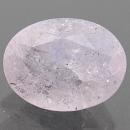|
|
||||||||||||||||
|
||||||||||||||||
|
||||||
|
|
|
|
Axinite-(Mg)
(Magnesio-Axinite)
|
|
| | |
| Discovered in 1975; IMA status: Valid (IMA approved 1975) | ||
|
| ||
|
Chemistry |
|
|
| |
|
Ca2MgAl2BSi4O15(OH) | |
|
|
Calcium Magnesium Aluminum Boron Sorosilicate Hydroxide |
|
Molecular Weight: |
538.57 gm |
|
Composition: |
Calcium |
14.88 % |
Ca |
20.82 % |
CaO |
|
|
Magnesium |
4.51 % |
Mg |
7.48 % |
MgO |
|
|
Aluminum |
10.02 % |
Al |
18.93 % |
Al2O3 |
|
|
Silicon |
20.86 % |
Si |
44.62 % |
SiO2 |
|
|
Boron |
2.01 % |
B |
6.46 % |
B2O3 |
|
|
Hydrogen |
0.19 % |
H |
1.67 % |
H2O |
|
|
Oxygen |
47.53 % |
O |
|
|
|
|
|
100.00 % |
|
100.00 % |
= TOTAL OXIDE |
|
|
|
||||
|
Classification |
|
|
| |
|
Silicates (Germanates) | |
|
8/E.06-10 | |
|
|
9 : SILICATES (Germanates)
|
|
Related to: |
Axinite Group. Axinite-(Fe)-Axinite-(Mg) Series. Magnesium analog of Axinite-(Fe) and Axinite-(Mn) |
|
Members of Group: |
Axinite Group: Axinite-(Fe), Axinite-(Mg), Axinite-(Mn), Tinzenite |
|
Varieties: |
n/a |
|
Synonyms: |
IMA1975-025, Magnesio-Axinite, Magnesium Axinite |
|
|
|
|
Crystal Data |
|
|
|
|
|
As crystals, to 3 cm, with the axe-head-shaped morphology typical of axinites; originally found as a rough gemstone. |
|
|
None |
|
|
|
|
|
Physical Properties |
|
|
|
|
|
Good on {100}, poor on {001}, {110}, and {011} (by analogy to the axinite group) |
|
|
Uneven to Conchoidal |
|
|
Brittle |
|
|
6.5 |
|
|
3.178 (g/cm3) |
|
|
Fluoresces red-orange in LW UV, duller red in SW UV |
|
|
Not Radioactive |
|
|
|
|
|
Optical Properties |
|
|
|
|
|
Pale Blue to pale Violet; light Brown to light Pink |
|
|
Transparent to Translucent |
|
|
Vitreous |
|
|
1.656 - 1.678 Biaxial ( + ) or ( - ) |
|
|
0.0090 - 0.0110 |
|
|
Strong; r > v |
|
|
Pale blue to pale violet and pale gray |
|
|
|
|
|
Occurances |
|
|
|
|
|
Geological Setting: |
Typically a mineral formed during contact metamorphism and boron metasomatism. |
|
Common Associations: |
Epidote, Tremolite, Calcite (London Bridge, Australia); Prehnite, Epidote, Actinolite, Vesuvianite (Luning, Nevada, USA) |
|
Common Impurities: |
Ti, V, Mn, Zn, K, H2O |
|
Type Locality: |
Merelani Hills (Mererani), Lelatema Mts, Arusha Region, Tanzania |
|
Year Discovered: |
1975; IMA approved 1975 |
|
View mineral photos: | |
|
|
|
|
More Information |
|
|
|
|
|
| |
|
|
|
|
Axinite-(Mg)
is only found at a few localities worldwide including
the type locality at the Merelani Hills,
Lelatema Mountains, Arusha Region, Tanzania; at London Bridge, near Queanbeyan,
New South Wales, Australia; Yankee Hill, Butte County,
California, USA; Luning area, Santa Fe district, Mineral County,
Nevada, USA. |
|
|
We
have not photographed our Axinite-(Mg) gems
yet. Please
check back soon. |
